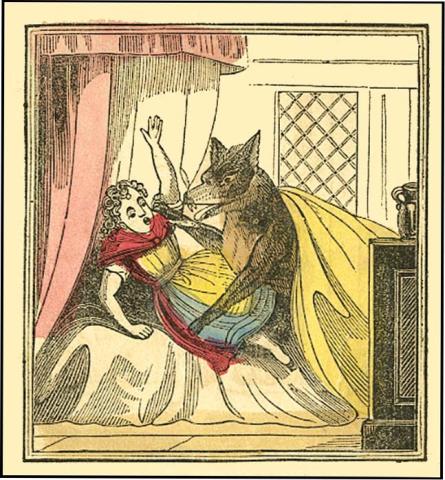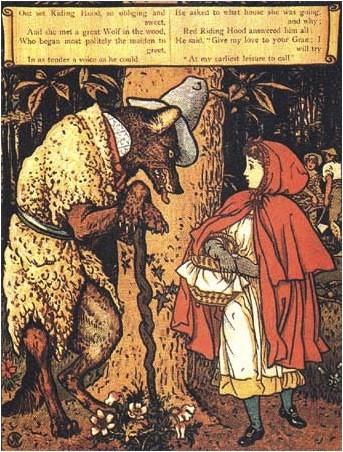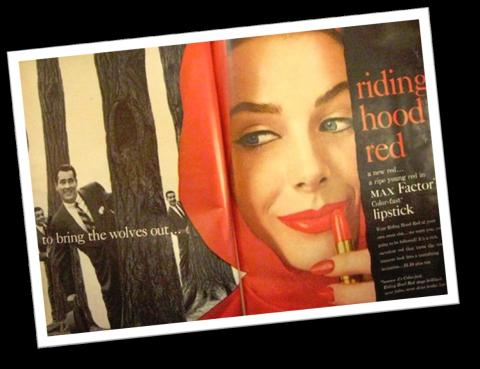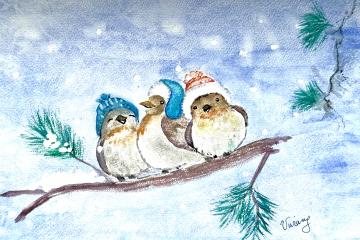Our December local lecturer, Olaf Winkler, journalist, architecture critic, guide and artist, introduced his lecture
Once upon a time …… “Little Red Riding Hood”
Once upon a time …… “Little Red Riding Hood”
16 Jun 2020
Once upon a time …
… “Little Red Riding Hood” was a seduction tale. An engraving accompanying the first published version of the story, in Paris in 1697, shows a girl in her déshabille, lying in bed beneath a wolf. According to the plot, she has just stripped off of her clothes, and a moment later the tale will end with her death in the beast’s jaws — no salvation, no redemption.
Any reader of the day would have immediately understood the message: In the French slang, when a girl lost her virginity it was said that elle avoit vû le loup — she’d seen the wolf.
Its author, Perrault, cloaked his heroine in red, the colour of scandal and blood, suggesting the girl’s sin and foreshadowing her fate. Her chaperon, or hood, also took on the tale’s lesson, acquiring the meaning in English, which it already possessed in French, of one who guards girls’ virtue. For good measure, Perrault added an explicit rhyming moral, admonishing demoiselles — that is, young ladies of society — to remain chaste:
Little girls, this seems to say, Never stop upon your way,
Never trust a stranger-friend; No one knows how it will end.
As you’re pretty so be wise; Wolves may lurk in every guise.
Handsome they may be, and kind, Gay, and charming — nevermind!
Now, as then, ‘tis simple truth — Sweetest tongue has sharpest tooth!
Though Perrault’s moral would eventually be eliminated from the fairy tale, his metaphor has survived to this day. Today we still use the term “wolf” to mean a man who chases women. This famous 1875 print by Walter Crane — appearing in a six-penny colour “toy book” that made the story immensely popular in England , a hub of children’s literature — shows the heroine cloaked in the garb and ideas of the Victorian working class. Women and children alike might be easily fooled by the wolf that Crane draws wearing a sheepskin — a Biblical reference to the Devil.
Today the prudish Brothers Grimm version of the fairy tale remains rife with suggestive details left over from Red Riding Hood’s racier French past, yet modern readers remain remarkably and sometimes comically oblivious.
Not until the 20th century was the bowdlerized Red Riding Hood defrocked, so to speak, and redressed. Advertisements transformed the heroine, once a symbolic warning against the female libido, into an ode to Lust. Ripe young “Riding Hood Red” lipstick would “bring the wolves out,” Max Factor promised, in a poster-sized ad appearing in Vogue in 1953.
“Without red, nothing doing,” declared a 1983 French advertisement for Johnnie Walker Red Label Scotch whisky, which showed a wolf bypassing a crestfallen girl clad in white. (Who wants to buy a drink for bleached goody-two-shoes?)
However, in 1990, the storybook was banned in two California school districts because of an illustration showing Red’s basket with a bottle of wine as well as fresh bread and butter. The story line of Red disrobing and climbing in bed with the wolf passed muster, but the wine, they said, might be seen as condoning the use of alcohol. (Clearly, a bigger danger than being eaten by a cross-dressing hairy imposter!)
Illustration2: Walter Crane, “Little Red Riding Hood Meets the Wolf in the Woods” 1875
About the Author
Jeni Fraser
JOIN OUR MAILING LIST
Become an instant expert!
Find out more about the arts by becoming a Supporter of The Arts Society.
For just £20 a year you will receive invitations to exclusive member events and courses, special offers and concessions, our regular newsletter and our beautiful arts magazine, full of news, views, events and artist profiles.
FIND YOUR NEAREST SOCIETY
MORE FEATURES
To further strengthen our connection with the island’s vibrant art scene, the Arts Society Mallorca is delighted to l
After careful thought, we will be discontinuing the Music Monthly newsletter.








